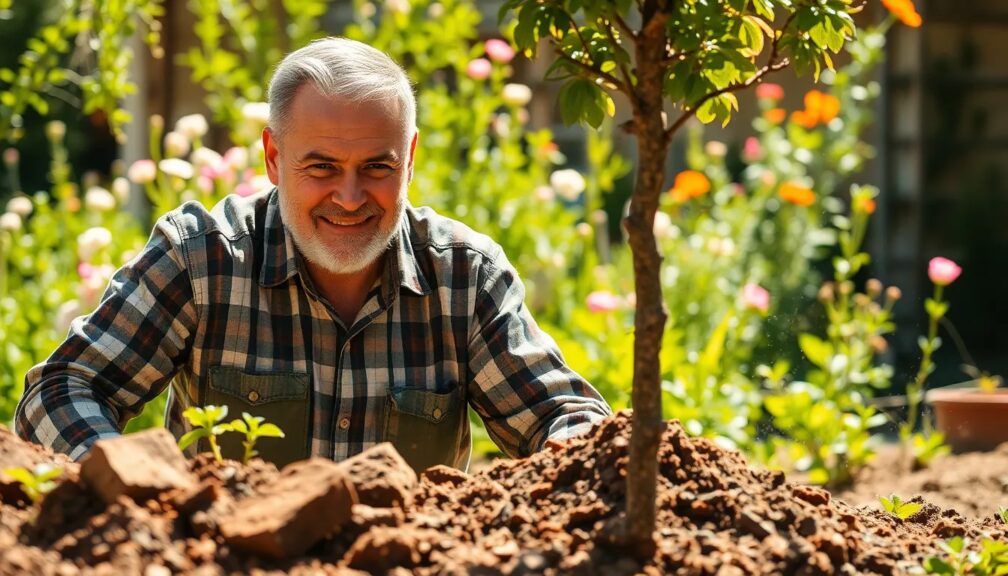What is the best tool for breaking up clay soil

Breaking up clay soil can be a daunting task for any gardener or landscaper. Dense and compact, clay soil presents a unique set of challenges that require the right tools and techniques to overcome. If you're struggling with hard, unyielding earth in your yard, you're probably searching for the best tool to make the job easier. In this article, we will explore the various tools designed to break up clay soil, from manual options like the garden fork and broadfork to powered devices such as tillers and cultivators. We'll compare their effectiveness, ease of use, and suitability for different soil conditions, helping you make an informed decision on the best investment for your garden. Whether you're a seasoned gardener or a beginner looking to improve your soil's condition, this guide will provide you with the knowledge you need to transform your clay soil into a fertile ground for a thriving garden.
How do you break down clay soil quickly?
Transforming your hard, compact clay soil into a plant-friendly haven can seem like a Herculean task, but with the right approach, you can achieve dramatic improvements in no time. Imagine stepping into your garden, only to find the soil is now a crumbly, nutrient-rich foundation supporting a vibrant ecosystem—this could be your reality sooner than you think!
Firstly, introducing organic matter is the tried-and-true method to enhance your clay soil rapidly. The addition of compost, well-rotted manure, or leaf mold invites beneficial microorganisms and worms that play a crucial role in breaking down the soil structure.
Gypsum is often hailed as a clay-buster, and for good reason. This mineral works wonders by displacing sodium—a culprit in clay compaction—and replacing it with calcium, which assists in loosening the soil.
Don't overlook the power of deep-rooting plants. Their roots dive into the clay, naturally aerating the soil and leaving behind channels that improve drainage and root penetration for future plantings.
Cover crops, such as clover or winter rye, aren't just for large-scale agriculture. Sowing these in your garden can protect and enrich your soil, as their decay provides organic matter and their roots break up the clay, enhancing its structure.
For an immediate solution, tilling can seem attractive, but it's a double-edged sword. While it can help in the short term, tilling can disrupt soil life and lead to further compaction down the line. Use this method with caution, and complement it with organic amendments to mitigate negative effects.
Are you ready to unlock the secrets to revitalizing your clay soil? The solution lies just beyond your fingertips, and with these strategies, your garden transformation is just around the corner. Embrace the change and watch as your soil goes from clay-clogged to garden-glorious!
What is the best tool to dig up clay soil?
If you're faced with the daunting task of breaking through heavy clay soil, you might be seeking the ultimate solution to transform your hard labor into a more efficient and less back-breaking experience. The secret lies in choosing the right tool, and while there are numerous options on the market, only a select few make the cut for being truly effective in tackling this challenging material.
Imagine effortlessly slicing through that stubborn earth, turning what could be hours of toil into a task that's accomplished with surprising ease. The key is a tool that combines strength, durability, and ergonomic design to ensure that you're working smarter, not harder.
The suspense is building, isn't it? Imagine the satisfaction of turning that dense, impenetrable ground into a perfectly tilled garden bed ready for planting. You're likely wondering, "What is this magical implement?" The answer may surprise you with its simplicity yet undeniable effectiveness.
Here are some characteristics to look for in your quest for the perfect tool:
1. A sharp, heavy-duty blade that can slice through clay soil like a knife through butter.
2. A comfortable grip to reduce hand and wrist fatigue during prolonged use.
3. A robust construction that won't bend or break under the pressure of the task.
But there's one tool that stands above the rest, a champion of garden implements that has gardeners everywhere singing its praises. Stay tuned, as we're about to unveil the gardening game-changer that will make you the master of your clay-laden landscape.
What is the best product to break up clay soil?
Have you ever faced the back-breaking challenge of tilling clay soil? It's a gardener's nightmare, compacted and unyielding, defying even the greenest thumbs. But what if there was a solution, a magic elixir that could turn this dense earth into a plant paradise?
Imagine transforming your clay battleground into a fertile oasis with minimal effort. The answer lies within innovative soil amendments, capable of revolutionizing your gardening experience. These products are not just mere additives; they're the key to unlocking the potential of your garden.
But don’t just take our word for it. Studies have shown that the incorporation of certain materials can significantly improve soil structure, leading to enhanced root penetration, better water retention, and ultimately, more robust plant growth.
So, what's this miraculous product? The anticipation is palpable, isn't it? We're talking about organic materials that work in tandem with nature. Products like:
1. Gypsum: A natural mineral that can work wonders by breaking down the compactness of the soil, improving drainage and aeration.
2. Composted Organic Matter: A treasure trove of nutrients, it not only conditions the soil but also feeds it, promoting beneficial microbial activity.
3. Sand: When used correctly, it can help to create air pockets within the clay, easing compaction.
Each of these options holds the promise of a lush garden, but the real secret to success is knowing how to use them effectively. The journey from clay to fertile loam is an art, with each step meticulously crafted to yield maximum results.
Imagine your garden, no longer a slave to the impermeable clay, but a thriving ecosystem brimming with life. Picture the earth crumbling between your fingers, the air filled with the scent of blooming flowers and the buzz of pollinators. This can be your reality.
As you stand on the precipice of this transformation, you may find yourself filled with curiosity, eager to delve deeper into the subject. What are the proportions to use? How do you apply them for the best effect? The answers to these questions and more await as we reveal the secrets to conquering clay soil. Stay tuned, for your garden transformation is just a read away.
What brakes up clay soil?
Transforming clay soil into a plant paradise is a secret every green-thumb enthusiast craves. But the real quest lies in the mystery of breaking it down effectively. Imagine discovering the techniques that turn that dense, sticky earth into a fertile haven. The truth is, various strategies are hidden just beneath the surface, waiting to be unearthed.
One crucial method involves the integration of organic matter. By infusing your soil with compost, aged manure, or leaf mold, you not only enrich the earth but also enhance its texture. This seemingly simple step is actually a game-changer, creating tiny airways and passages within the clay, that encourage root growth and water movement.
But wait, there's more. The use of gypsum, a mineral that dives deep into the clay matrix, is another insider secret. This powerhouse doesn't just break the soil apart; it also battles the high pH often associated with clay, making it a haven for a wider variety of plants.
Are you on the edge of your seat yet? Because the addition of sand takes things to a whole new level. Though not a standalone solution, when mixed with organic matter, sand can help to further loosen the tight grip of clay particles.
Now, if you're picturing a year-long endeavor, hold onto your hats. There are quick-fix options that promise to make you the envy of the neighborhood. Have you ever heard of liquid aerators? These innovative solutions seep into the soil, breaking it apart without the backbreaking work of mechanical aeration.
The rabbit hole goes deeper, though. Cultivating certain plants, like deep-rooting vegetables and cover crops, can naturally aerate the soil and break it up over time. It's like having an army of tiny gardeners working around the clock to condition your soil.
Feeling that itch of curiosity? You should. The art of breaking up clay soil is packed with secrets, each promising to turn your garden into an oasis bursting with life. And you, my friend, are just a few paragraphs away from unlocking this treasure trove of gardening gold. Stay tuned, as we delve into the alchemy of soil transformation that is sure to change your horticultural world forever.
Best tool to break up hard soil
Are you struggling with unyielding earth in your garden? Imagine wielding a tool so effective it transforms your toughest ground into a bed of fluffy loam, ready for planting. The secret lies in the tool you choose, and I'm about to reveal the gardener's favorite that promises to make that soil surrender beneath your fingertips.
First off, let's talk about the traditional garden spade. It's not just a classic—this tool has been the backbone of many successful gardens. Its flat, sharp edge cuts into hard soil, making it ideal for edging and sod removal. But when it comes to breaking new ground, you might need something with a little more oomph.
Enter the garden fork, a formidable opponent against compacted soil. With its sturdy tines, it can penetrate areas where a spade meets resistance. However, its true power is unleashed when you wiggle it back and forth to loosen and aerate the hardest of soils.
Yet neither of these tools holds a candle to the might of the broadfork. This dual-handled tool works with your body's natural mechanics, allowing you to step down on its crossbar and use your weight to drive the tines into the ground. A simple see-saw motion breaks up clods and slices through roots, requiring minimal effort for maximum impact.
But wait, there's more. Have you heard of the rotary tiller? This motorized marvel eats through soil like it's butter. Perfect for larger plots, it saves time and spares you the back-breaking labor.
Finally, the crown jewel, the tool that is whispered about in gardening circles, is the electric soil cultivator. Compact, powerful, and astonishingly efficient, it's designed to target and pulverize the toughest of terrains. Imagine no more wrestling with the earth—this tool does the heavy lifting for you.
So which of these champions of the garden will help you claim victory over hard-packed soil? Stay tuned, and I'll guide you through the pros and cons of each, ensuring that your next encounter with hardened earth is not a battle, but a triumph.
Consejo final: For tackling clay soil, consider investing in a broadfork or a rotary tiller. These tools can significantly ease the process, breaking up compacted clay and enhancing soil structure. Remember to amend the soil with organic matter to improve its quality over time. Take your time and be patient—transforming clay soil is a gradual process. Wishing you success in your gardening endeavors!
 Does wetting soil make it easier to dig
Does wetting soil make it easier to dig What is the easiest way to dig a hole in hard ground
What is the easiest way to dig a hole in hard ground How to keep rats away
How to keep rats away What are the tools used in gardening: Your essential guide
What are the tools used in gardening: Your essential guide What is the most popular gardening tool and why it's essential?
What is the most popular gardening tool and why it's essential?If you want to know more about similar articles like What is the best tool for breaking up clay soil you can visit category Gardening Tools.